Mass Customisation Strategies in Additive Manufacturing: A Systematic Review and Implementation Framework
Abstract
1. Introduction
- RQ1: What are the different mass customisation implementation strategies in AM (2010–2024)?
- RQ2: What are the technological ecosystems including technological enablers and barriers in AM-enabled mass customisation?
- RQ3: What are the evaluation methodologies and performance metrics for assessing the viability of AM-based mass customisation implementations?
- RQ4: What are the industry-specific applications and outcomes of AM-based mass customisation?
- RQ5: How can a comprehensive multi-layered implementation framework for AM-based on mass customisation be developed that integrates strategic, operational, and evaluative dimensions while addressing industry-specific considerations and technological factors?
2. Materials and Methods
2.1. Study Selection and Eligibility Criteria
2.2. Data Extraction and Quality Assessment
2.3. Data Analysis and Synthesis
3. Results
3.1. Descriptive Analysis of Included Studies
3.2. Thematic Analysis
3.2.1. Mass Customisation Implementation Strategies in AM
Integration of AM with Traditional Manufacturing
Customer-Centric Design Integration
Flexible Manufacturing Networks
Adaptive Production Systems
3.2.2. Technological Ecosystem for AM Mass Customisation
Technical Enablers for Mass Customisation
Technical Barriers and Implementation Challenges
Quality Control and Process Optimisation
Digital Integration and Data Management
3.2.3. Industry-Specific Applications and Outcomes
Medical and Dental Applications
Industrial and Engineering Applications
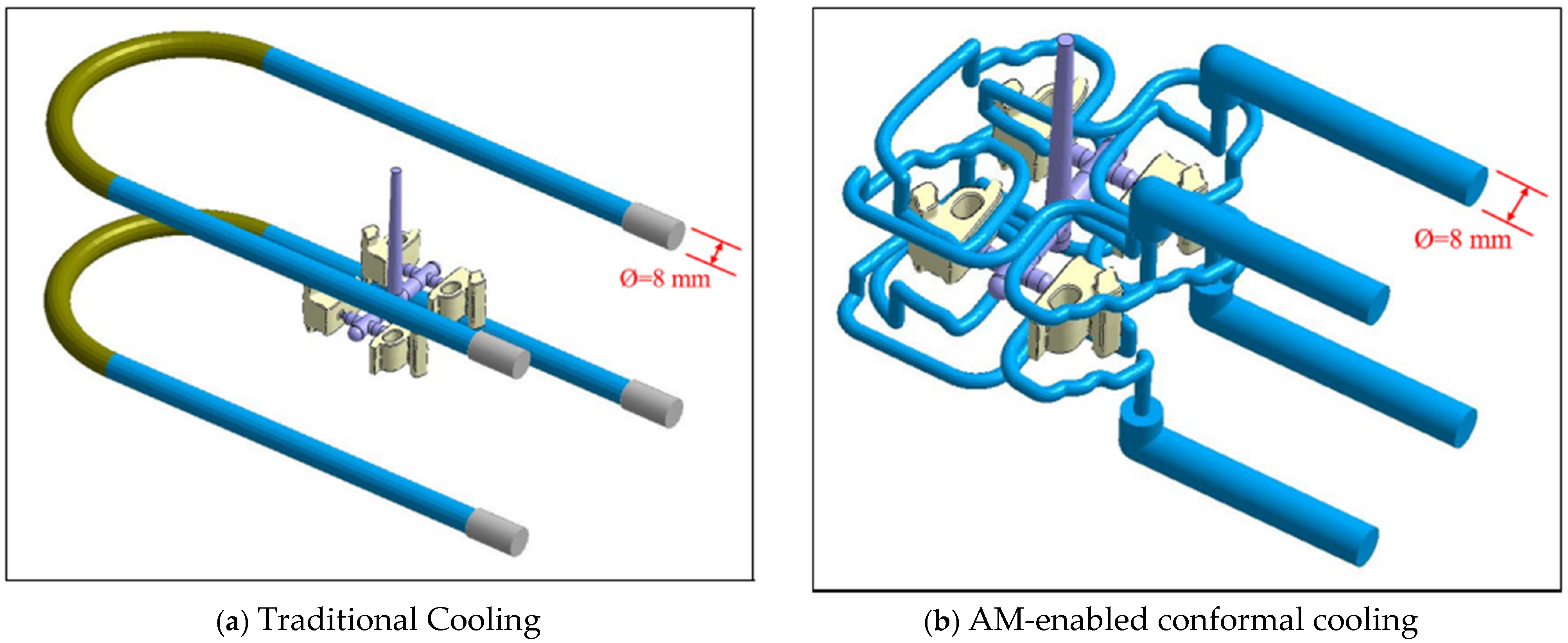
Architectural and Construction Applications
3.2.4. Evaluation Methodologies and Performance Metrics
Cost–Benefit Analysis Frameworks
Quality Assessment Methods
Performance Evaluation Systems
4. AM-Enabled Mass Customisation Implementation Framework
5. Conclusions and Prospects
5.1. Practical Implications
5.2. Research Limitations
5.3. Future Research Directions
Author Contributions
Funding
Data Availability Statement
Acknowledgments
Conflicts of Interest
References
- Jafar, M.R.; Tripathi, N.M.; Yadav, M.; Nasato, D.S. Additive Manufacturing in the Age of Industry 4.0 and Beyond. In Advances in Pre- and Post-Additive Manufacturing Processes; CRC Press: Boca Raton, FL, USA, 2024; pp. 213–230. [Google Scholar] [CrossRef]
- Lacroix, R.; Timonina-Farkas, A.; Seifert, R.W. Utilizing additive manufacturing and mass customization under capacity constraints. J. Intell. Manuf. 2023, 34, 281–301. [Google Scholar] [CrossRef] [PubMed]
- Kim, S.; Lee, K. The paradigm shift of mass customisation research. Int. J. Prod. Res. 2023, 61, 3350–3376. [Google Scholar] [CrossRef]
- Renjith, S.C.; Park, K.; Okudan Kremer, G.E. A Design Framework for Additive Manufacturing: Integration of Additive Manufacturing Capabilities in the Early Design Process. Int. J. Precis. Eng. Manuf. 2020, 21, 329–345. [Google Scholar] [CrossRef]
- Jankovics, D.; Barari, A. Customization of Automotive Structural Components using Additive Manufacturing and Topology Optimization. IFAC-PapersOnLine 2019, 52, 212–217. [Google Scholar] [CrossRef]
- Marinho De Brito, F.; Junior, G.D.C.; Frazzon, E.M.; Basto, J.P.T.V.; Alcala, S.G.S. Design Approach for Additive Manufacturing in Spare Part Supply Chains. IEEE Trans. Ind. Inform. 2021, 17, 757–765. [Google Scholar] [CrossRef]
- Stentoft, J.; Wickstrøm, K.A.; Haug, A.; Philipsen, K. Additive manufacturing–enabled innovation in small- and medium-sized enterprises: The role of readiness in make-or-buy decisions. Ind. Manag. Data Syst. 2023, 123, 1768–1788. [Google Scholar] [CrossRef]
- Khorram Niaki, M.; Nonino, F.; Tafakkori, K.; Torabi, S.A.; Kazemian, I. The influence of manufacturing contexts on additive manufacturing-enabled competitive capabilities. J. Manuf. Technol. Manag. 2022, 33, 1102–1123. [Google Scholar] [CrossRef]
- Wazeer, A.; Das, A.; Sinha, A.; Inaba, K.; Ziyi, S.; Karmakar, A. Additive manufacturing in biomedical field: A critical review on fabrication method, materials used, applications, challenges, and future prospects. Prog. Addit. Manuf. 2022, 8, 857–889. [Google Scholar] [CrossRef]
- Shidid, D.; Leary, M.; Choong, P.; Brandt, M. Just-in-time design and additive manufacture of patient-specific medical implants. Phys. Procedia 2016, 83, 4–14. [Google Scholar] [CrossRef]
- Paoletti, I. Mass Customization with Additive Manufacturing: New Perspectives for Multi Performative Building Components in Architecture. Procedia Eng. 2017, 180, 1150–1159. [Google Scholar] [CrossRef]
- Yu, Y.; Kim, G.; Mathur, K. A critical review of additive manufacturing: An innovation of mass customization. J. Text. Appar. Technol. Manag. 2020, 11, 1–16. [Google Scholar]
- Pajonk, A.; Prieto, A.; Blum, U.; Knaack, U. Multi-material additive manufacturing in architecture and construction: A review. J. Build. Eng. 2022, 45, 103603. [Google Scholar] [CrossRef]
- Korner, M.E.H.; Lambán, M.P.; Albajez, J.A.; Santolaria, J.; Corrales, L.D.C.N.; Royo, J. Systematic literature review: Integration of additive manufacturing and industry 4.0. Metals 2020, 10, 1061. [Google Scholar] [CrossRef]
- Moher, D.; Liberati, A.; Tetzlaff, J.; Altman, D.G. Preferred reporting items for systematic reviews and meta-analyses: The PRISMA statement. BMJ 2009, 339, 332–336. [Google Scholar] [CrossRef]
- Liberati, A.; Altman, D.G.; Tetzlaff, J.; Mulrow, C.; Gøtzsche, P.C.; Ioannidis, J.P.A.; Clarke, M.; Devereaux, P.J.; Kleijnen, J.; Moher, D. The PRISMA statement for reporting systematic reviews and meta-analyses of studies that evaluate healthcare interventions: Explanation and elaboration. BMJ 2009, 339, b2700. [Google Scholar] [CrossRef]
- Page, M.J.; Moher, D.; Bossuyt, P.M.; Boutron, I.; Hoffmann, T.C.; Mulrow, C.D.; Shamseer, L.; Tetzlaff, J.M.; Akl, E.A.; Brennan, S.E.; et al. PRISMA 2020 explanation and elaboration: Updated guidance and exemplars for reporting systematic reviews. BMJ 2021, 372, n160. [Google Scholar] [CrossRef]
- Agrawal, S.; Oza, P.; Kakkar, R.; Tanwar, S.; Jetani, V.; Undhad, J.; Singh, A. Analysis and recommendation system-based on PRISMA checklist to write systematic review. Assess. Writ. 2024, 61, 100866. [Google Scholar] [CrossRef]
- Page, M.J.; McKenzie, J.E.; Bossuyt, P.M.; Boutron, I.; Hoffmann, T.C.; Mulrow, C.D.; Shamseer, L.; Tetzlaff, J.M.; Moher, D. Updating guidance for reporting systematic reviews: Development of the PRISMA 2020 statement. J. Clin. Epidemiol. 2021, 134, 103–112. [Google Scholar] [CrossRef]
- Mongeon, P.; Paul-Hus, A. The journal coverage of Web of Science and Scopus: A comparative analysis. Scientometrics 2016, 106, 213–228. [Google Scholar] [CrossRef]
- Baas, J.; Schotten, M.; Plume, A.; Côté, G.; Karimi, R. Scopus as a curated, high-quality bibliometric data source for academic research in quantitative science studies. Quant. Sci. Stud. 2020, 1, 377–386. [Google Scholar] [CrossRef]
- Bramer, W.; Rethlefsen, M.; Kleijnen, J.; Franco, O.H. Optimal database combinations for literature searches in systematic reviews: A prospective exploratory study. Syst. Rev. 2017, 6, 245. [Google Scholar] [CrossRef] [PubMed]
- Zhu, J.; Liu, W. A tale of two databases: The use of Web of Science and Scopus in academic papers. Scientometrics 2020, 123, 321–335. [Google Scholar] [CrossRef]
- Pranckutė, R. Web of Science (WoS) and Scopus: The Titans of Bibliographic Information in Today’s Academic World. Publications 2021, 9, 12. [Google Scholar] [CrossRef]
- Singh, S.; Mehla, S.; Bhargava, S.K.; Ramakrishna, S. History and Evolution of Additive Manufacturing. In Additive Manufacturing for Chemical Sciences and Engineering; Springer: Berlin/Heidelberg, Germany, 2022; pp. 19–51. [Google Scholar] [CrossRef]
- CASP Checklist Website. Available online: https://casp-uk.net/casp-tools-checklists/ (accessed on 4 April 2025).
- Mishra, S.; Dey, A.K. Understanding and Identifying ‘Themes’ in Qualitative Case Study Research. South Asian J. Bus. Manag. Cases 2022, 11, 187–192. [Google Scholar] [CrossRef]
- Creswell, J.W.; Plano Clark, V.L. Designing and Conducting Mixed Methods Research, 3rd ed.; SAGE Scientific Research Publishing: Thousand Oaks, CA, USA, 2018. [Google Scholar]
- Williams, M.; Moser, T. The Art of Coding and Thematic Exploration in Qualitative Research: International Management Review. Int. Manag. Rev. 2019, 15, 45–55. [Google Scholar]
- O’Connor, C.; Joffe, H. Intercoder Reliability in Qualitative Research: Debates and Practical Guidelines. Int. J. Qual. Methods 2020, 19, 1609406919899220. [Google Scholar] [CrossRef]
- Lee, Y.J.; Lee, J.Y.; Cho, J.H.; Choi, J.H. Interrater reliability of sleep stage scoring: A meta-analysis. J. Clin. Sleep Med. 2022, 18, 193–202. [Google Scholar] [CrossRef]
- Allen Forster, C.U.J.T. Validating coding for a theoretical model of information behaviour. Inf. Res. 2008, 13, 13–14. [Google Scholar]
- Zawadzki, P.; Żywicki, K. Smart product design and production control for effective mass customization in the Industry 4.0 concept. Manag. Prod. Eng. Rev. 2016, 7, 105–112. [Google Scholar] [CrossRef]
- Jiang, Z.; Wen, H.; Han, F.; Tang, Y.; Xiong, Y. Data-driven generative design for mass customization: A case study. Adv. Eng. Inform. 2022, 54, 101786. [Google Scholar] [CrossRef]
- Yuan, P.F.; Beh, H.S.; Yang, X.; Zhang, L.; Gao, T. Feasibility study of large-scale mass customization 3D printing framework system with a case study on Nanjing Happy Valley East Gate. Front. Archit. Res. 2022, 11, 670–680. [Google Scholar] [CrossRef]
- Hafenecker, J.; Rigas, N.; Merklein, M. Laser-based ultrasonic measurement of the influence of PBF-LB/M-typical thermal cycles on sheet metal components of hybrid parts. Prod. Eng. 2023, 17, 861–873. [Google Scholar] [CrossRef]
- Rajamani, P.K.; Ageyeva, T.; Kovács, J.G. Personalized Mass Production by Hybridization of Additive Manufacturing and Injection Molding. Polymers 2021, 13, 309. [Google Scholar] [CrossRef] [PubMed]
- Rousseau, M.; Medini, K.; Romero, D.; Wuest, T. Configurators as a means to Leverage Customer-Centric Sustainable Systems—Evidence from the 3D-Printing Domain. Procedia CIRP 2020, 96, 103–108. [Google Scholar] [CrossRef]
- Rayna, T.; Striukova, L.; Darlington, J. Co-creation and user innovation: The role of online 3D printing platforms. J. Eng. Technol. Manag. 2015, 37, 90–102. [Google Scholar] [CrossRef]
- Zanetti, V.; Cavalieri, S.; Kalchschmidt, M.; Pinto, R. The Role of Additive Manufacturing in the B2C Value Chain: Challenges, Opportunities and Models. In Proceedings of the IFIP International Conference on Advances in Production Management Systems, Tokyo, Japan, 7–9 September 2015; pp. 137–145. [Google Scholar] [CrossRef]
- Narendran, N.; Perera, I.U.; Mou, X.; Thotagamuwa, D.R. Opportunities and challenges for 3D printing of solid-state lighting systems. In Proceedings of the Sixteenth International Conference on Solid State Lighting and LED-Based Illumination Systems, San Diego, CA, USA, 6–10 August 2017; SPIE: Bellingham, WA, USA, 2017; Volume 35. [Google Scholar] [CrossRef]
- Lunetto, V.; Priarone, P.C.; Galati, M.; Minetola, P. On the correlation between process parameters and specific energy consumption in fused deposition modelling. J. Manuf. Process. 2020, 56, 1039–1049. [Google Scholar] [CrossRef]
- Kim, S.; Jeong, B. Mass customization capability planning with additive manufacturing. IFIP Adv. Inf. Commun. Technol. 2018, 535, 184–192. [Google Scholar] [CrossRef]
- Sun, H.; Zou, B.; Wang, X.; Chen, W.; Zhang, G.; Quan, T.; Huang, C. Advancements in multi-material additive manufacturing of advanced ceramics: A review of strategies, techniques and equipment. Mater. Chem. Phys. 2024, 319, 129337. [Google Scholar] [CrossRef]
- Kumar Rana, A.; Kundu, S.; Kayal, S. Digital fabrication with FDM 3D printing on prototype development of toys: Additive manufacturing and sustainability. In Proceedings of the 16th International Conference on Materials Processing and Characterization (ICMPC 2024), Ahmedabad, India, 27–29 June 2024. [Google Scholar] [CrossRef]
- Lin, D.; Zhang, Y.; Jiang, B. Identification of Factors Affecting the Application of Additive Manufacturing Technology in Mass Customization Based on Structural Equation Model. IEEE Int. Conf. Ind. Eng. Eng. Manag. 2022, 2022, 137–141. [Google Scholar] [CrossRef]
- Pesce, A.; Hornés, A.; Núñez, M.; Morata, A.; Torrell, M.; Tarancón, A. 3D printing the next generation of enhanced solid oxide fuel and electrolysis cells †. J. Mater. Chem. A 2020, A8, 16926–16932. [Google Scholar] [CrossRef]
- Schubert, C.; Van Langeveld, M.C.; Donoso, L.A. Innovations in 3D printing: A 3D overview from optics to organs. Br. J. Ophthalmol. 2014, 98, 159–161. [Google Scholar] [CrossRef] [PubMed]
- García-Dominguez, A.; Claver, J.; Sebastián, M.A. Optimization Methodology for Additive Manufacturing of Customized Parts by Fused Deposition Modeling (FDM). Application to a Shoe Heel. Polymers 2020, 12, 2119. [Google Scholar] [CrossRef] [PubMed]
- Turner, R.D.; Wingham, J.R.; Paterson, T.E.; Shepherd, J.; Majewski, C. Use of silver-based additives for the development of antibacterial functionality in Laser Sintered polyamide 12 parts. Sci. Rep. 2020, 10, 892. [Google Scholar] [CrossRef]
- Shen, Z.; Shang, X.; Zhao, M.; Dong, X.; Xiong, G.; Wang, F.Y. A learning-based framework for error compensation in 3D printing. IEEE Trans. Cybern. 2019, 49, 4042–4050. [Google Scholar] [CrossRef]
- Bos, F.; Ahmed, Z.; Rodriguez, C.R.; Figueiredo, S.C. 3D Concrete Printing for Structural Applications. SPOOL 2019, 6, 5–10. [Google Scholar] [CrossRef]
- Gao, M.; Li, L.; Wang, Q.; Liu, C.; Li, X.; Liu, Z. Feature-based energy consumption quantitation strategy for complex additive manufacturing parts. Energy 2024, 297, 131249. [Google Scholar] [CrossRef]
- Lacroix, R.; Seifert, R.W.; Timonina-Farkas, A. Benefiting from additive manufacturing for mass customization across the product life cycle. Oper. Res. Perspect. 2021, 8, 100201. [Google Scholar] [CrossRef]
- Li, Y.; Wu, H.; Tamir, T.S.; Shen, Z.; Liu, S.; Hu, B.; Xiong, G. An efficient product-customization framework based on multimodal data under the social manufacturing paradigm. Machines 2023, 11, 170. [Google Scholar] [CrossRef]
- da Silva, D.P.; Pinheiro, J.; Abdulghani, S.; Lorger, C.K.; Martinez, J.C.; Solano, E.; Mateus, A.; Pascoal-Faria, P.; Mitchell, G.R. Changing the Paradigm-Controlling Polymer Morphology during 3D Printing Defines Properties. Polymers 2022, 14, 1638. [Google Scholar] [CrossRef]
- Gulisano, V.; Papatriantafilou, M.; Chen, Z.; Hryha, E.; Nyborg, L.; Nyborg, L. Towards data-driven additive manufacturing processes. In Proceedings of the 23rd International Middleware Conference Industrial Track, Quebec, QC, Canada, 7–11 November 2022; pp. 43–49. [Google Scholar] [CrossRef]
- Sivabalakrishnan, R.; Kalaiarasan, A.; Ajithvishva, M.S.; Hemsri, M.; Oorappan, G.M.; Yasodharan, R. IoT visualization of Smart Factory for Additive Manufacturing System (ISFAMS) with visual inspection and material handling processes. IOP Conf. Ser. Mater. Sci. Eng. 2020, 995, 012027. [Google Scholar] [CrossRef]
- Olakanmi, E.O.; Cochrane, R.F.; Dalgarno, K.W. A review on selective laser sintering/melting (SLS/SLM) of aluminium alloy powders: Processing, microstructure, and properties. Prog. Mater. Sci. 2015, 74, 401–477. [Google Scholar] [CrossRef]
- Giunta, L.; Hicks, B.; Snider, C.; Gopsill, J. A Living Lab Platform for Testing Additive Manufacturing Agent-Based Manufacturing Strategies. Procedia CIRP 2023, 119, 656–661. [Google Scholar] [CrossRef]
- Leong, K.F.; Teng, P.S.P.; Er, B.H.; Tee, C.H. Mass customization and testing of braces using additive manufacturing. Mater. Today Proc. 2022, 70, 593–598. [Google Scholar] [CrossRef]
- Solaimani, S.; Parandian, A.; Nabiollahi, N. A holistic view on sustainability in additive and subtractive manufacturing: A comparative empirical study of eyewear production systems. Sustainability 2021, 13, 10775. [Google Scholar] [CrossRef]
- Bilalis, L.; Canellidis, V.; Papatheodorou, T.; Giannatsis, J. Direct Digital Manufacturing of a Customized Face Mask. J. Manuf. Mater. Process. 2022, 6, 126. [Google Scholar] [CrossRef]
- Du, Y.; Chen, J.; Meng, Q.; Dou, Y.; Xu, J.; Shen, S.Z. Thermoelectric materials and devices fabricated by additive manufacturing. Vacuum 2020, 178, 109384. [Google Scholar] [CrossRef]
- Kromoser, B.; Pachner, T. Optiknot 3D—Free-Formed Frameworks out of Wood with Mass Customized Knots Produced by FFF Additive Manufactured Polymers: Experimental Investigations, Design Approach and Construction of a Prototype. Polymers 2020, 12, 965. [Google Scholar] [CrossRef]
- Lacava, H.; Cherrington, N.; Corrado, A.; Bigdellou, S.; Chen, Q. A Preliminary Study of 3D Printing Home Designs for Improving Efficiency and Sustainability of Indigenous Housing in Canada. Sustainability 2024, 16, 5781. [Google Scholar] [CrossRef]
- Bayraklilar, M.S. Dimensional Accuracy of Acrylonitrile Butadiene Styrene Material Produced by Additive Manufacturing Method. J. Mater. Eng. Perform. 2024, 33, 2531–2551. [Google Scholar] [CrossRef]
- Filip Górski, P.; Zawadzki, P.; Wichniarek, R.; Kuczko, W.; Slupinska, S.; Zukowska, M. Automated Design and Rapid Manufacturing of Low-Cost Customized Upper Limb Prostheses. J. Phys. Conf. Ser. 2022, 2198, 012040. [Google Scholar] [CrossRef]
- He, Q.; Han, L. Research on Adaptive Repair Technology of 3D Printing Based on Convolutional Neural Network. In Proceedings of the 2021 IEEE 21st International Conference on Communication Technology (ICCT), Tianjin, China, 13–16 October 2021. [Google Scholar]
- Hauser, M.; King, R.; Wysk, R.; Harrysson, O. Resource Planning for Direct Fabrication of Customized Orthopedic Implants Using EBM Technology. J. Manuf. Syst. 2021, 60, 500–511. [Google Scholar] [CrossRef]
- Alabbasi, M.; Agkathidis, A.; Chen, H. Robotic 3D printing of concrete building components for residential buildings in Saudi Arabia. Autom. Constr. 2023, 148, 104751. Available online: https://www.sciencedirect.com/science/article/pii/S0926580523000110 (accessed on 5 April 2025). [CrossRef]
- Deradjat, D.; Minshall, T. Decision trees for implementing rapid manufacturing for mass customisation. CIRP J. Manuf. Sci. Technol. 2018, 23, 156–171. [Google Scholar] [CrossRef]
- Huang, J.; Sun, H.; Kwok, T.-H.; Zhou, C.; Xu, W. Geometric Deep Learning for Shape Correspondence in Mass Customization by Three-Dimensional Printing. J. Manuf. Sci. Eng. 2020, 142, 061003. [Google Scholar] [CrossRef]
- Basak, S.; Baumers, M.; Holweg, M.; Hague, R.; Tuck, C. Reducing production losses in additive manufacturing using overall equipment effectiveness. Addit. Manuf. 2022, 56, 102904. [Google Scholar] [CrossRef]
- Martinez-Marquez, D.; Mirnajafizadeh, A.; Carty, C.P.; Stewart, R.A. Application of quality by design for 3D printed bone prostheses and scaffolds. PLoS ONE 2018, 13, e0195291. [Google Scholar] [CrossRef]
- Frohn-Sörensen, P.; Geueke, M.; Engel, B.; Löffler, B.; Bickendorf, P.; Asimi, A.; Bergweiler, G.; Schuh, G. Design for 3D Printed Tools: Mechanical Material Properties for Direct Polymer Additive Tooling. Polymers 2022, 14, 1694. [Google Scholar] [CrossRef]
- Koop, C.; Grosse Erdmann, J.; Koller, J.; Döpper, F. Circular Business Models for Remanufacturing in the Electric Bicycle Industry. Front. Sustain. 2021, 2, 785036. [Google Scholar] [CrossRef]
- Richter, A.; Kessing, D.; Fischer, F.; Pelzer, L.; Dilger, K. Print-on strategies to bond injection molded parts with structures produced by fused-deposition-modeling. In Proceedings of the Design Society: International Conference on Engineering Design, Delf, The Netherlands, 5–8 August 2019; pp. 5–8. [Google Scholar] [CrossRef][Green Version]
- Büscher, J.; Zajackowski, J.; Rademacher, H.G.; Tillmann, W.; Deuse, J. Trustworthiness of artificial intelligence applications for quality optimisation in metal additive manufacturing. Procedia CIRP 2024, 122, 497–502. [Google Scholar] [CrossRef]
- Sæterbø, M.; Solvang, W.D. A Readiness Model for Facilitating the Implementation of Metal Additive Manufacturing at SMEs. In Proceedings of the 2023 IEEE Conference on Technologies for Sustainability (SusTech), Portland, OR, USA, 19–22 April 2023. [Google Scholar] [CrossRef]
- Wang, P.; Li, J.; Yang, J.; Wang, G.; He, L.; Manufacturing, H.Z.-A. Enabling 3D multilayer electronics through the hybrid of vat photopolymerization and laser-activated selective metallization. Addit. Manuf. 2023, 74, 103717. [Google Scholar] [CrossRef]
- Abdulhameed, O.; Mian, S.H.; Moiduddin, K.; Al-Ahmari, A.; Ahmed, N.; Aboudaif, M.K. A multi-part orientation planning schema for fabrication of non-related components using additive manufacturing. Micromachines 2022, 13, 1777. [Google Scholar] [CrossRef] [PubMed]
- Bellens, S.; Guerrero, P.; Janssens, M.; Vandewalle, P.; Dewulf, W. Machine learning based sinogram interpolation for X-ray computed tomography validated on experimental data. Precis. Eng. 2024, 88, 449–463. [Google Scholar] [CrossRef]
- Lin, K.-W.; Chou, L.-W.; Su, Y.-T.; Wei, S.-H.; Chen, C.-S. Biomechanical Effect of 3D-Printed Foot Orthoses in Patients with Knee Osteoarthritis. Appl. Sci. 2021, 11, 4200. [Google Scholar] [CrossRef]
- García-Dominguez, A.; Claver, J.; Sebastián, M.A. Integration of additive manufacturing, parametric design, and optimization of parts obtained by fused deposition modeling (fdm). A methodological approach. Polymers 2020, 12, 1993. [Google Scholar] [CrossRef]
- Gibson, I.; Rosen, D.; Stucker, B. Direct Digital Manufacturing. In Additive Manufacturing Technologies; Springer: Berlin/Heidelberg, Germany, 2015; pp. 375–397. [Google Scholar] [CrossRef]
- Ngo, T.D.; Kashani, A.; Imbalzano, G.; Nguyen, K.T.Q.; Hui, D. Additive manufacturing (3D printing): A review of materials, methods, applications and challenges. Compos. B Eng. 2018, 143, 172–196. [Google Scholar] [CrossRef]
- Rayna, T.; Striukova, L. Involving consumers: The role of digital technologies in promoting ’prosumption’and user innovation. J. Knowl. Econ. 2021, 12, 218–237. [Google Scholar] [CrossRef]
- Pallari, J.H.P.; Dalgarno, K.W.; Woodburn, J. Mass customization of foot orthoses for rheumatoid arthritis using selective laser sintering. IEEE Trans. Biomed. Eng. 2010, 57, 1750–1756. [Google Scholar] [CrossRef]
- Górski, F.; Suszek, E.; Wichniarek, R.; Kuczko, W.; Żukowska, M. Rapid Manufacturing of Individualized Prosthetic Sockets. Adv. Sci. Technol. Res. J. 2020, 14, 42–49. [Google Scholar] [CrossRef]
- Lu, Y. Industry 4.0: A survey on technologies, applications and open research issues. J. Ind. Inf. Integr. 2017, 6, 1–10. [Google Scholar] [CrossRef]
- Thompson, S.M.; Bian, L.; Shamsaei, N.; Yadollahi, A. An overview of Direct Laser Deposition for additive manufacturing; Part I: Transport phenomena, modeling and diagnostics. Addit. Manuf. 2015, 8, 36–62. [Google Scholar] [CrossRef]
- Dzogbewu, T.C.; Amoah, N.; Fianko, S.K.; Afrifa, S.; De Beer, D. Additive manufacturing towards product production: A bibliometric analysis. Manuf. Rev. 2022, 9, 1. [Google Scholar] [CrossRef]
- Carlone, P.; Palazzo, G.S. Influence of Process Parameters on Microstructure and Mechanical Properties in AA2024-T3 Friction Stir Welding. Metallogr. Microstruct. Anal. 2013, 2, 213–222. [Google Scholar] [CrossRef]
- Maamoun, A.H.; Xue, Y.F.; Elbestawi, M.A.; Veldhuis, S.C. Effect of Selective Laser Melting Process Parameters on the Quality of Al Alloy Parts: Powder Characterization, Density, Surface Roughness, and Dimensional Accuracy. Materials 2018, 11, 2343. [Google Scholar] [CrossRef] [PubMed]
- Gockel, J.; Sheridan, L.; Koerper, B.; Whip, B. The influence of additive manufacturing processing parameters on surface roughness and fatigue life. Int. J. Fatigue 2019, 124, 380–388. [Google Scholar] [CrossRef]
- Tamir, T.S.; Xiong, G.; Fang, Q.; Yang, Y.; Shen, Z.; Zhou, M.C.; Jiang, J. Machine-learning-based monitoring and optimization of processing parameters in 3D printing. Int. J. Comput. Integr. Manuf. 2023, 36, 1362–1378. [Google Scholar] [CrossRef]
- Gudiño Paredes, S.; Jasso Peña, F.d.J.; de La Fuente Alcazar, J.M. Remote proctored exams: Integrity assurance in online education? Distance Educ. 2021, 42, 200–218. [Google Scholar] [CrossRef]
- Frank, S.B.; Christian, A.; Michael, G.; Christian, K.; Gounet, H.P. Towards the Automation of Non-destructive Fault Recognition: Enhancement of Robustness and Accuracy Through AI Powered Acoustic and Thermal Signal Analysis. J. Fail. Anal. Prev. 2024, 24, 2210–2220. [Google Scholar] [CrossRef]
- Baranašić, Z. Additive Manufacturing-Digital Transformation in Manufacturing Business Models. Ph.D. Thesis, University of Zagreb, Zagreb, Croatia, 2022. [Google Scholar]
- Mavroidis, C.; Ranky, R.G.; Sivak, M.L.; Patritti, B.L.; DiPisa, J.; Caddle, A.; Gilhooly, K.; Govoni, L.; Sivak, S.; Lancia, M.; et al. Patient specific ankle-foot orthoses using rapid prototyping. J. Neuroeng. Rehabil. 2011, 8, 1. [Google Scholar] [CrossRef]
- Dzogbewu, T.C.; Fianko, S.K.; Amoah, N.; Afrifa, S., Jr.; de Beer, D. Additive manufacturing in South Africa: Critical success factors. Heliyon 2022, 8, e11852. [Google Scholar] [CrossRef]
- Kim, H.; Lee, D.; Lee, S.Y.; Yang, H.; Park, S.-W.; Lim, H.-P.; Yun, K.-D.; Park, C. Denture flask fabrication using fused deposition modeling three-dimensional printing. Elsevier 2020, 64, 231–234. [Google Scholar] [CrossRef]
- Abdulhameed, O.; Al-Ahmari, A.; Ameen, W.; Mian, S.H. Additive manufacturing: Challenges, trends, and applications. Adv. Mech. Eng. 2019, 11, 1687814018822880. [Google Scholar] [CrossRef]
- Lee Ventola, C. Medical Applications for 3D Printing: Current and Projected Uses. Pharm. Ther. 2014, 39, 704. [Google Scholar]
- Gorelik, M. Additive manufacturing in the context of structural integrity. Int. J. Fatigue 2017, 94, 168–177. [Google Scholar] [CrossRef]
- Gibson, I.; Rosen, D.; Stucker, B.; Khorasani, M. Directed Energy Deposition. In Additive Manufacturing Technologies; Springer: Berlin/Heidelberg, Germany, 2021; pp. 285–318. [Google Scholar] [CrossRef]
- Chung, C.Y.; Liu, C.J. Metal additive manufacturing of conformal cooling channels for improving the quality of metal injection–molded products. Adv. Mech. Eng. 2024, 16, 16878132241282210. [Google Scholar] [CrossRef]
- Metal Additive Manufacturing Magazine. GE Aviation Reaches Milestone with 100,000 Fuel Nozzle Tips. Available online: https://www.metal-am.com/ge-aviation-reaches-milestone-with-100000-fuel-nozzle-tips/ (accessed on 29 May 2025).
- The Fabricator. Daimler Buses Rolls Out a Mobile Additive Manufacturing Service Center. Available online: https://www.thefabricator.com/additivereport/news/additive/daimler-buses-rolls-out-a-mobile-additive-manufacturing-service-center (accessed on 30 May 2025).
- Dancel, R. 3D Printed House for Disaster-Affected Areas. In Proceedings of the 2019 DLSU Disaster Risk Reduction and Infrastructure Development (DRRID) Forum, Taft, Manila, 19–21 June 2019. [Google Scholar] [CrossRef]
- Stuart-Smith, R. Towards Technically Progressive and Speculative Design Education: Penn MSD-RAS’s Collaborative and Interdisciplinary Pedagogy. In Proceedings of the ACSA/EAAE Teachers Conference, Educating the Cosmopolitan Architect, Reykjavik, Iceland, 22–24 June 2023; pp. 181–188. [Google Scholar] [CrossRef]
- Suntharalingam, T.; Upasiri, I.; Gatheeshgar, P.; Poologanathan, K.; Nagaratnam, B.; Rajanayagam, H.; Navaratnam, S. Fire resistance of 3D printed concrete composite wall panels exposed to various fire scenarios. J. Struct. Fire Eng. 2021, 12, 377–409. [Google Scholar] [CrossRef]
- Bechthold, M. Ceramic prototypes-design, computation, and digital fabrication. Inf. Constr. 2016, 68, e167. [Google Scholar] [CrossRef][Green Version]
- Fang, Q.; Xiong, G.; Zhou, M.; Tamir, T.S.; Yan, C.B.; Wu, H.; Shen, Z.; Wang, F.Y. Process monitoring, diagnosis and control of additive manufacturing. IEEE Trans. Autom. Sci. Eng. 2022, 21, 1041–1067. [Google Scholar] [CrossRef]
- Hora, M.; Hankammer, S.; Canetta, L.; Sel, S.K.; Gomez, S.; Gahrens, S. Designing business models for sustainable mass customization: A framework proposal. Int. J. Ind. Eng. Manag. 2016, 7, 143–152. [Google Scholar] [CrossRef]
- Machado, C.G.; Despeisse, M.; Winroth, M.; da Silva, E.H.D.R. Additive manufacturing from the sustainability perspective: Proposal for a self-assessment tool. Procedia CIRP 2019, 81, 482–487. [Google Scholar] [CrossRef]
- Meyer, A.D.; Tsui, A.S.; Hinings, C.R. Configurational Approaches to Organizational Analysis. Acad. Manag. J. 2017, 36, 1175–1195. [Google Scholar] [CrossRef]
- Barney, J. Firm Resources and Sustained Competitive Advantage. J. Manag. 1991, 17, 99–120. [Google Scholar] [CrossRef]
- Robert, M. Porter’s Competitive Advantage of Nations: An Assessment. Strateg. Manag. J. 1991, 12, 535–548. [Google Scholar]
- Teece, D.J.; Pisano, G.; Shuen, A. Dynamic capabilities and strategic management. Strateg. Manag. J. 1997, 18, 509–533. [Google Scholar] [CrossRef]
- Eisenhardt, K.M.; Martin, J.A. Dynamic capabilities: What are they? Strateg. Manag. J. 2000, 21, 1105–1121. [Google Scholar] [CrossRef]
- Trist, E. The Evolution of Socio-Technical Systems. 1981. Available online: https://www.lmmiller.com/blog/wp-content/uploads/2013/06/The-Evolution-of-Socio-Technical-Systems-Trist.pdf (accessed on 15 April 2025).
- Baxter, G.; Sommerville, I. Socio-technical systems: From design methods to systems engineering. Interact. Comput. 2010, 23, 4–17. [Google Scholar] [CrossRef]
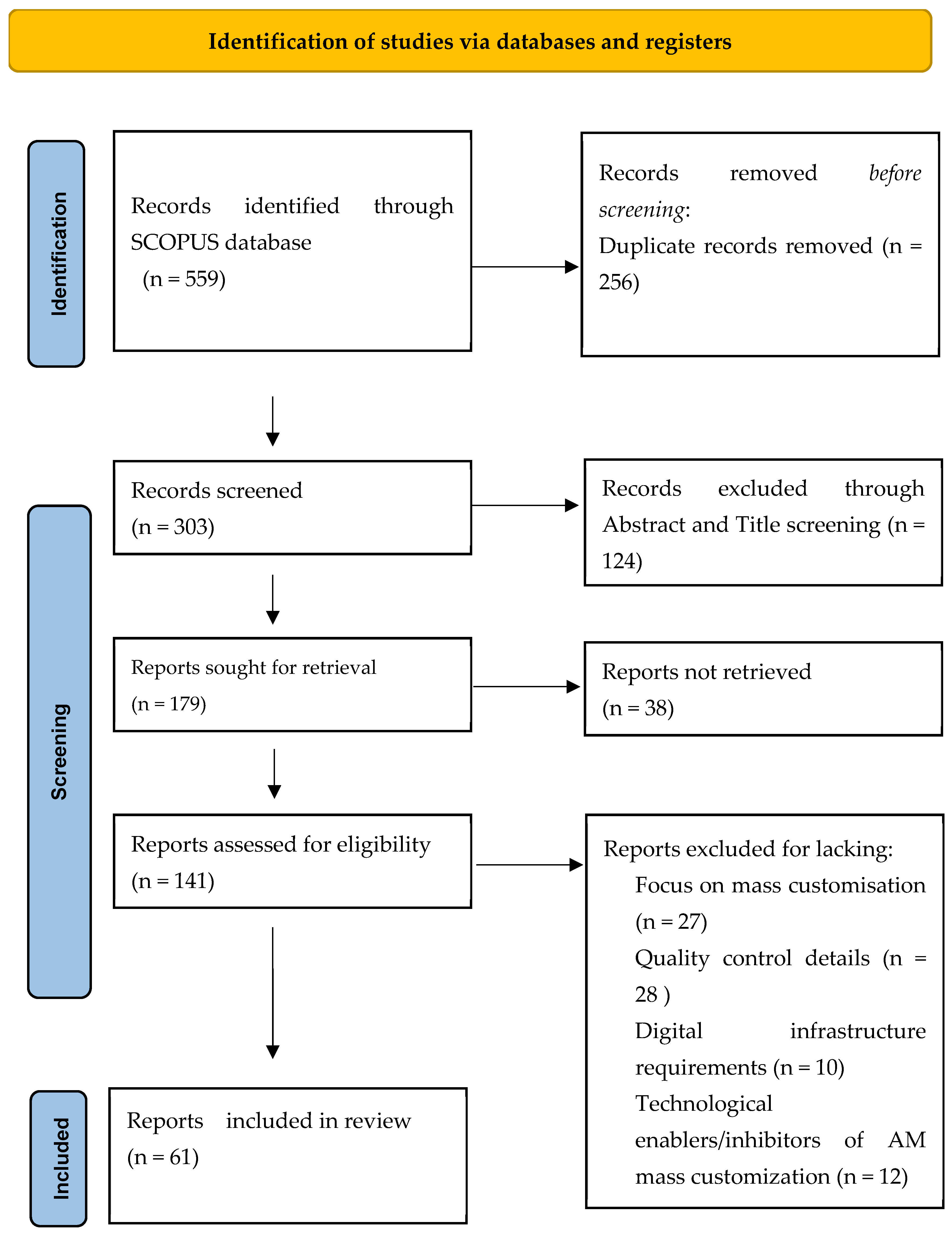
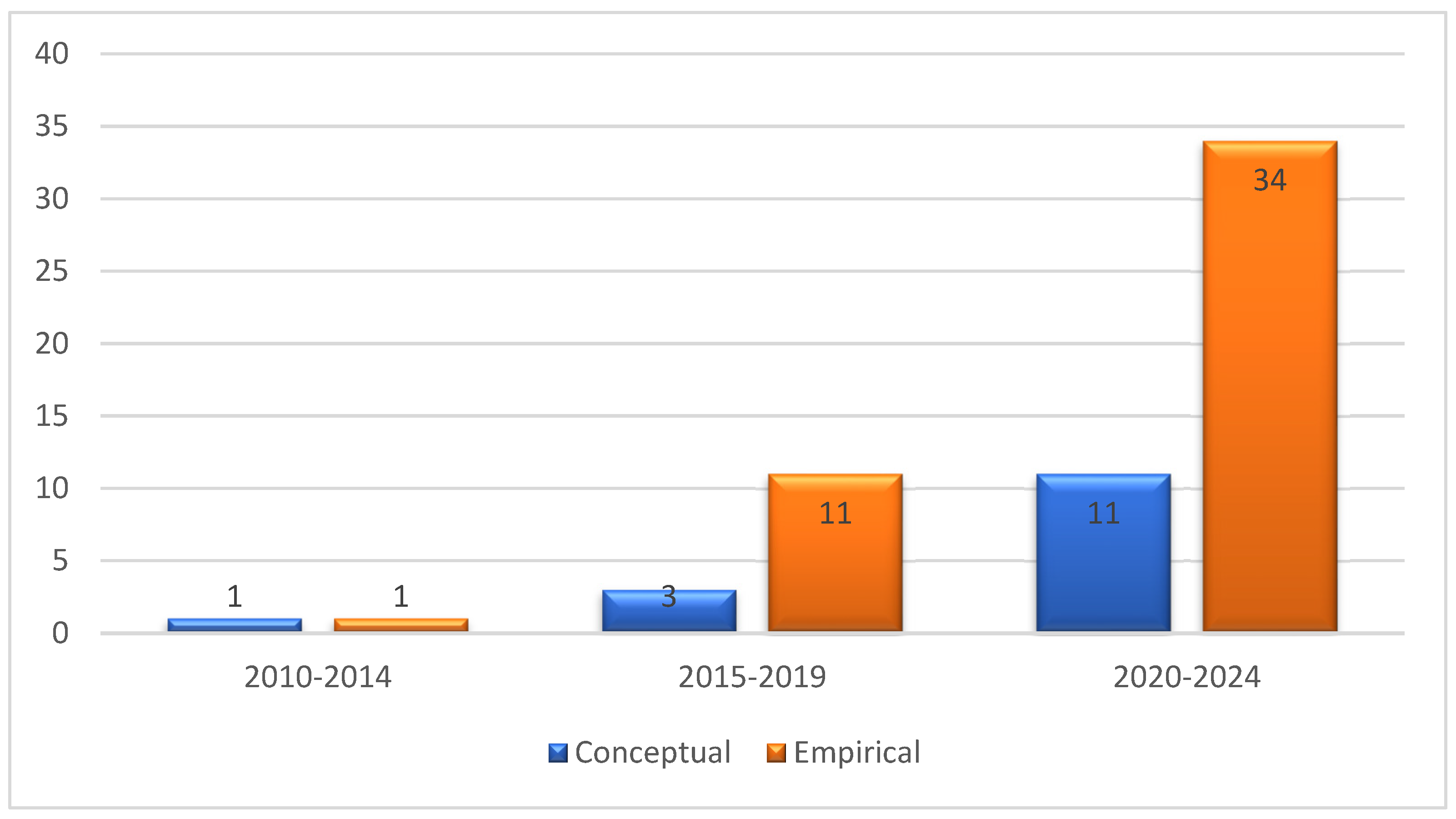
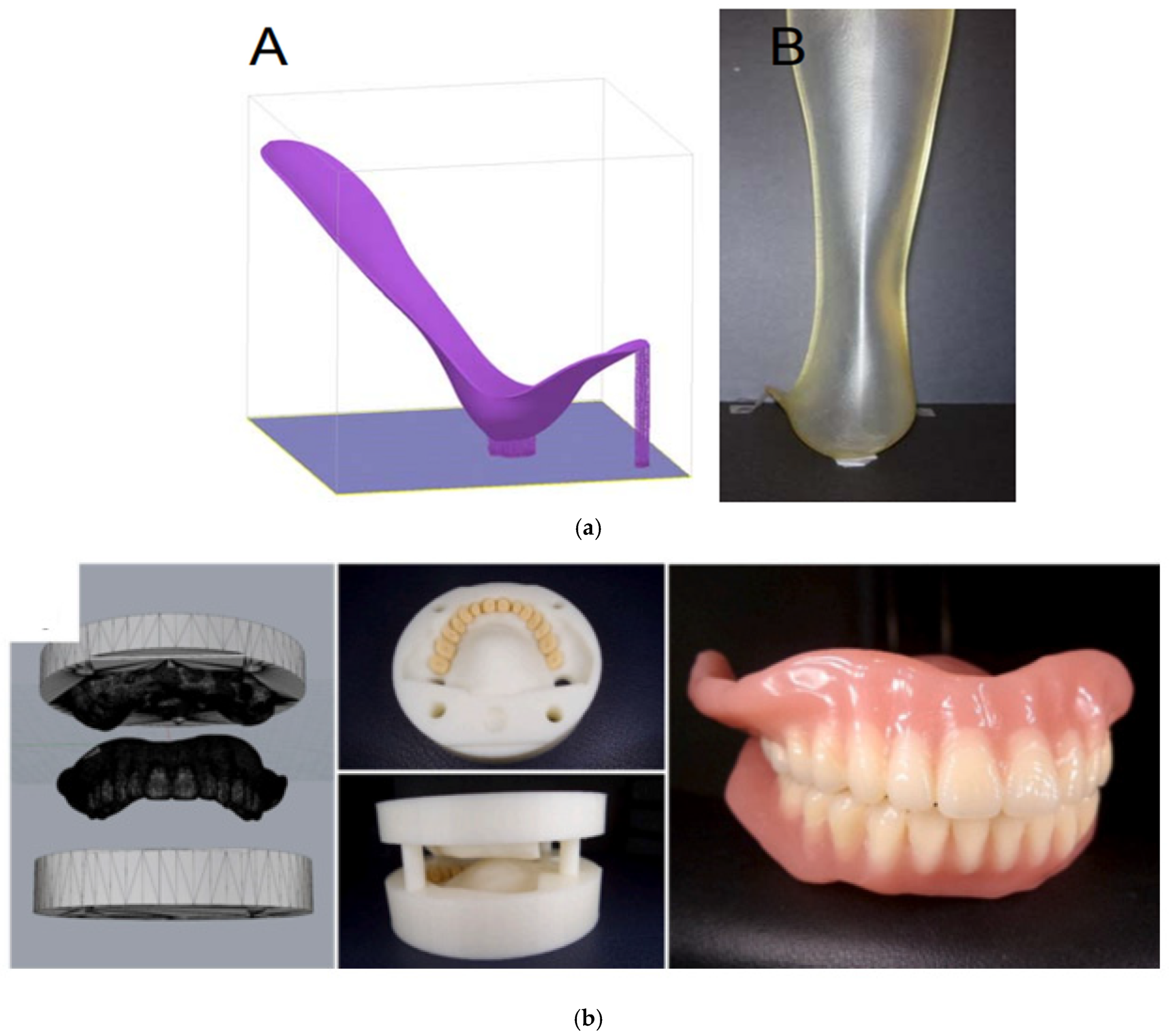

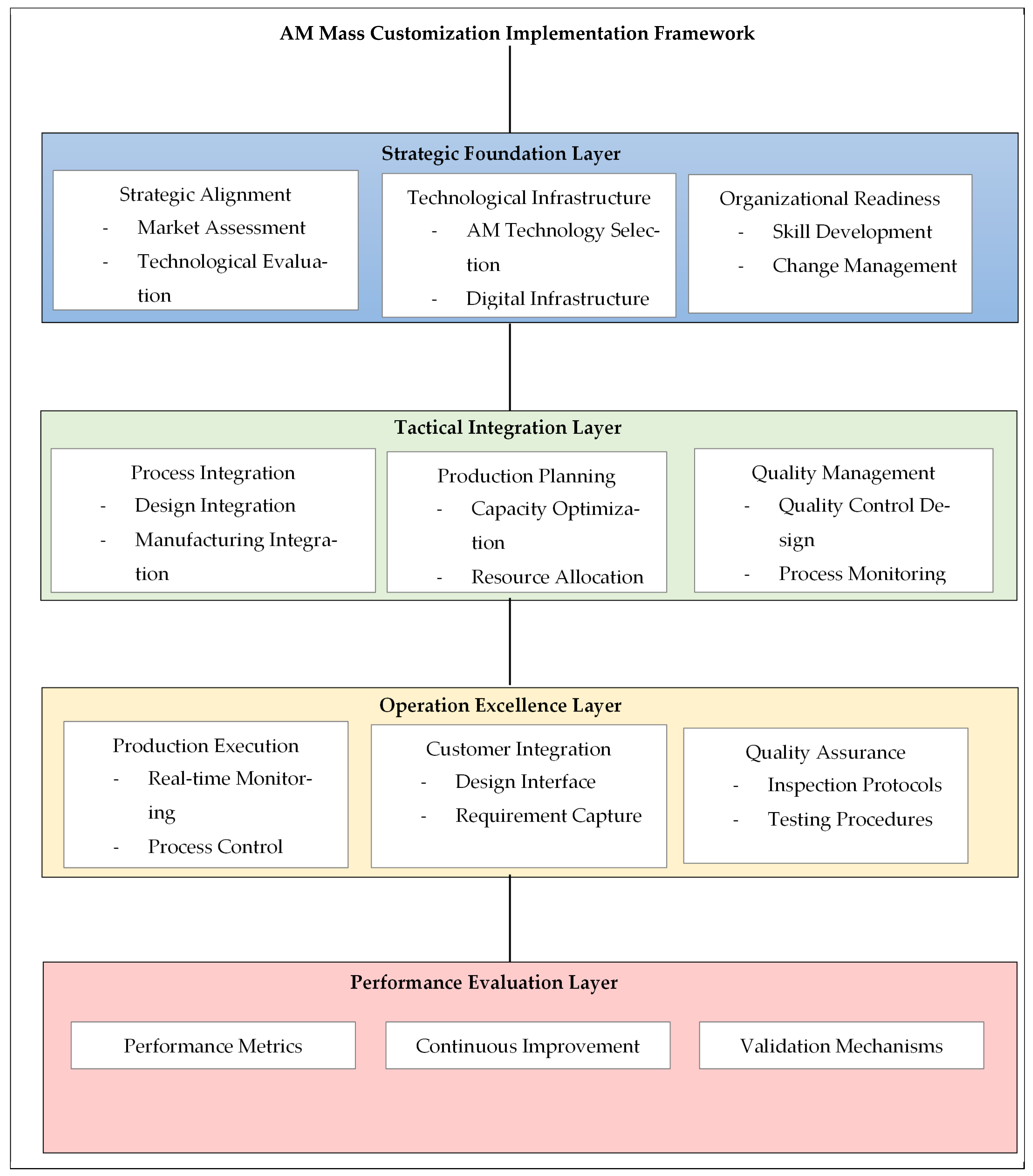
| Thematic Area | Sub-Dimensions | Papers |
| Mass customisation implementation strategies in AM |
| Zawadzki and Żywicki [33], Jiang et al. [34], Kang and Lee [3], Yuan et al. [35], Hafenecker et al. [36], Paoletti [11], Lacroix et al. [2], Kim and Lee [3], Rajamani et al. [37], Rousseau et al. [38], Rayna et al. [39], Zanetti et al. [40] |
| Technological ecosystem for AM mass customisation |
| Narendran et al. [41], Lunetto et al. [42], Kumar and Jeong [43], Sun et al. [44], Kumar et al. [45], Lin et al. [46], Pesce et al. [47], Schubert et al. [48], García-Dominguez et al. [49], Turner et al. [50], Shen et al. [51], Bos et al. [52], Gao et al. [53], Lacroix et al. [54], Li et al. [55], da Silva et al. [56], Gulisano et al. [57], Sivabalakrishnan et al. [58], Olakanmi et al. [59], Giunta et al. [60] |
| Industry-specific applications and outcomes |
| Leong et al. [61], Solaimani et al. [62], Bilalis et al. [63], Rana et al. [45], Du et al. [64], Kromoser and Pachner [65], Lacava et al. [66], Bayraklilar [67], Górski et al. [68], He and Han [69], Hauser et al. [70], Alabbasi et al. [71] |
| Evaluation methodologies and performance metrics |
| Deradjat and Minshall [72], Huang et al. [73], Basak et al. [74], Martinez-Marquez et al. [75], Frohn-Sörensen et al. [76], Rajamani et al. [37], Zanetti et al. [40], Koop et al. [77], Richter et al. [78], Büscher et al. [79], Sæterbø and Solvang [80], Wang et al. [81], Abdulhameed et al. [82], Bellens et al. [83], Kim and Jeong [43], Huang et al. [73], Lin et al. [84], García-Dominguez et al. [85] |
| Application Area | AM Tools and Method | Specific Products | Clinical Benefits | Cost and Time Benefits | Key Challenges | Supporting Research |
|---|---|---|---|---|---|---|
| Medical Prosthetics |
|
|
|
|
| [63,89] |
| Dental Prosthetics |
|
|
|
|
| [61,63] |
| Orthopedic Medicine |
|
|
|
|
| [75,89,90] |
| AM Strategy | Industrial Products | Key Applications | Cross-Industry Implementation | Supporting Evidence |
|---|---|---|---|---|
| Integration with Traditional |
|
| Tooling: Primary strategy for hybrid manufacturing and optimised cooling channel design Automotive: Critical for safety-critical components requiring high precision | [37,63,75] |
| Customer-Centric Design |
|
| Aerospace: Primary strategy for topology optimisation and lightweight high-performance components Automotive: Emphasis on personalised interiors and ergonomic customisation | [45,47] |
| Flexible Networks |
|
| Spare Parts: Primary strategy for distributed on-demand manufacturing All Industries: Enables regional customisation and reduced lead times | [64] |
| Adaptive Systems |
|
| Aerospace: Combined with Customer-Centric Design for real-time optimisation Tooling: Used for optimised cooling channel design based on process data | [82] |
| AM Strategy | Construction Products | Key Applications | Challenges | Supporting Evidence |
|---|---|---|---|---|
| Customer-Centric Design Integration |
|
|
| [52,66,71] |
| Adaptive Production Systems |
|
|
| [52,65,71] |
| Integration with Traditional Manufacturing |
|
|
| [64,70,71] |
| Flexible Manufacturing Networks |
|
|
| [65,71] |
Disclaimer/Publisher’s Note: The statements, opinions and data contained in all publications are solely those of the individual author(s) and contributor(s) and not of MDPI and/or the editor(s). MDPI and/or the editor(s) disclaim responsibility for any injury to people or property resulting from any ideas, methods, instructions or products referred to in the content. |
© 2025 by the authors. Licensee MDPI, Basel, Switzerland. This article is an open access article distributed under the terms and conditions of the Creative Commons Attribution (CC BY) license (https://creativecommons.org/licenses/by/4.0/).
Share and Cite
Fianko, S.K.; Dzogbewu, T.C.; Agbamava, E.; de Beer, D.J. Mass Customisation Strategies in Additive Manufacturing: A Systematic Review and Implementation Framework. Processes 2025, 13, 1855. https://doi.org/10.3390/pr13061855
Fianko SK, Dzogbewu TC, Agbamava E, de Beer DJ. Mass Customisation Strategies in Additive Manufacturing: A Systematic Review and Implementation Framework. Processes. 2025; 13(6):1855. https://doi.org/10.3390/pr13061855
Chicago/Turabian StyleFianko, Samuel Koranteng, Thywill Cephas Dzogbewu, Edinam Agbamava, and Deon Johan de Beer. 2025. "Mass Customisation Strategies in Additive Manufacturing: A Systematic Review and Implementation Framework" Processes 13, no. 6: 1855. https://doi.org/10.3390/pr13061855
APA StyleFianko, S. K., Dzogbewu, T. C., Agbamava, E., & de Beer, D. J. (2025). Mass Customisation Strategies in Additive Manufacturing: A Systematic Review and Implementation Framework. Processes, 13(6), 1855. https://doi.org/10.3390/pr13061855








